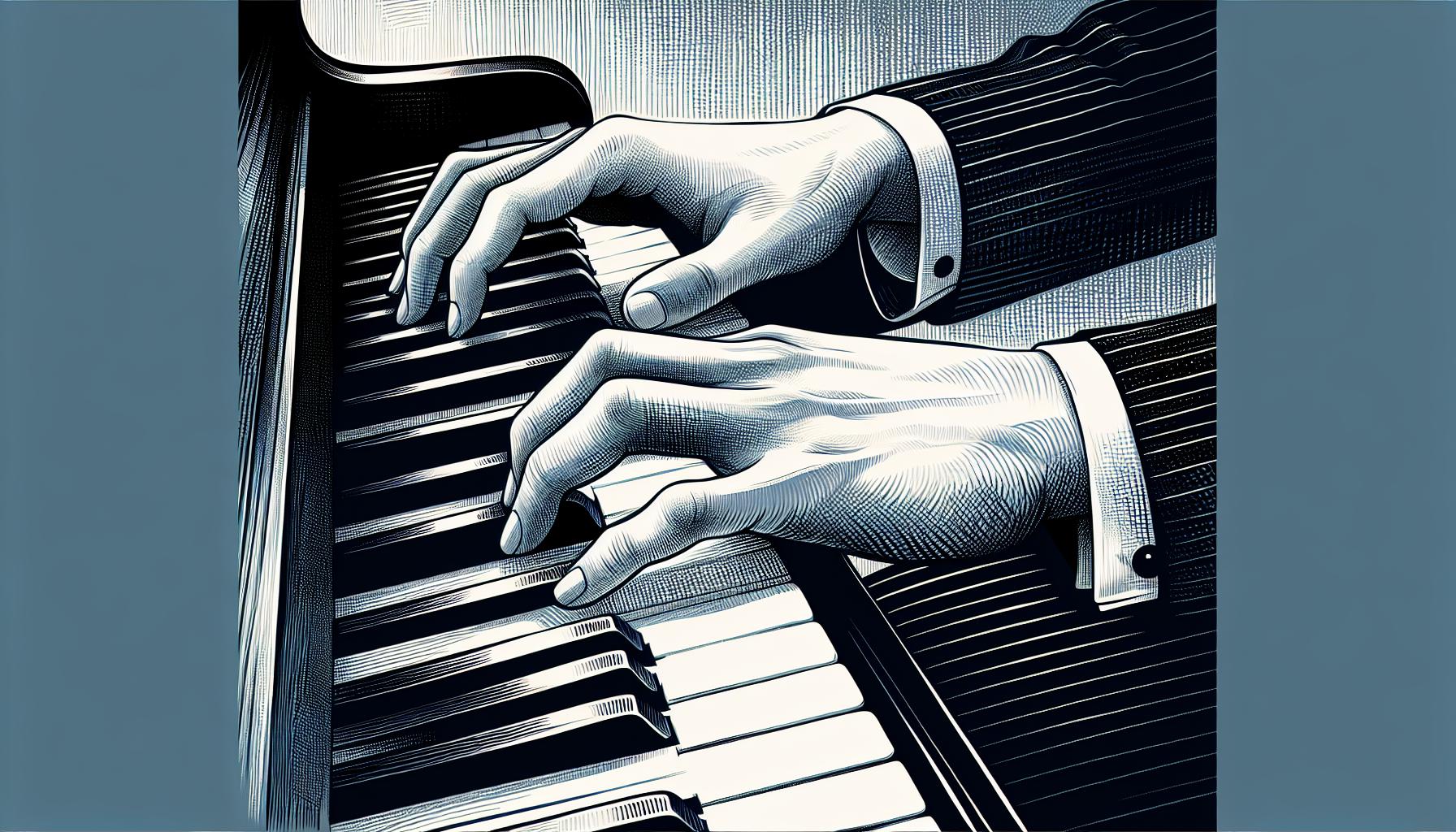Diving into the world of piano playing can be as thrilling as it is daunting, especially when it comes to mastering dynamics. It's not just about hitting the right notes; it's about bringing a piece to life with the ebb and flow of volume and intensity. For beginners, understanding and applying dynamics can be the difference between playing notes and making music.
Imagine sitting at the piano, your fingers poised and ready, as you embark on a journey not just of precision, but of expression. Dynamics are the heart and soul of music, offering a palette of emotions to paint each piece with unique shades of loud and soft, intense and gentle. Let's explore how beginners can unlock this crucial aspect of piano playing, transforming their performances from mere melodies to captivating musical narratives.
Exploring the Importance of Dynamics in Piano Playing
Dynamics in piano playing aren't just about the volume at which notes are played; they're the vessel through which emotions flow from the musician to their audience. For beginners, understanding and mastering dynamics can truly elevate their performances from simple melodies to stirring musical experiences. It’s the difference between playing music and telling a captivating story.
At the core, dynamics allow pianists to express feelings and emotions that cannot be conveyed through words alone. They add color, contrast, and depth to music, enabling a piece to breathe and evolve throughout its duration. Whether it’s the gentle caress of a pianissimo passage or the bold declaration of a fortissimo section, each dynamic mark guides the pianist in shaping the mood and character of the piece. It's not merely about playing louder or softer; it's about understanding the emotional weight behind each note and phrase.
For beginners, the journey into dynamics starts with familiarization. Recognizing symbols like pp (pianissimo, very quiet), p (piano, quiet), mf (mezzo-forte, moderately loud), f (forte, loud), and ff (fortissimo, very loud) is the first step. But knowing what they signify and how to implement them effectively is where the real learning begins. Each piece of music comes with its own emotional landscape, and it's up to the pianist to navigate this with sensitivity and understanding.
Utilizing dynamics also requires a good deal of control and technique. Beginners must learn to adjust their touch on the keys, controlling finger strength, and weight to produce the desired sound. Exercises focused on dynamics can help in developing this control. For instance, practicing scales or passages with varying dynamics can train the fingers to respond with the necessary delicacy or power.
Moreover, dynamics are not static; they're fluid and often subject to the interpretation of the pianist. Two performers might approach the same piece with different dynamic interpretations, each adding their unique emotional insight and thus creating distinct renditions of the same composition. This aspect of dynamics opens a world of creative expression for pianists, allowing them to connect more deeply with their music and audiences alike.
Understanding the Basics of Piano Dynamics

Diving into the world of piano dynamics for beginners might seem daunting at first, but it's an exciting journey into expressing emotions and storytelling through music. At its core, dynamics refer to the volume of the sound produced by the piano, ranging from soft whispers of melody to powerful crescendos that fill the room. They're notated in sheet music using symbols like pp (pianissimo, very soft), p (piano, soft), mf (mezzo-forte, moderately loud), f (forte, loud), and ff (fortissimo, very loud). These symbols serve as a map, guiding performers on how to convey the music's emotional landscape.
But it's not just about following these symbols; playing with dynamics requires a combination of technical skill and emotional sensitivity. For beginners, it starts with developing a responsive touch on the piano keys. This involves practicing the ability to press the keys with different levels of force, which directly affects the volume of the sound. It might seem simple in theory, but in practice, it demands a keen ear and a nuanced touch.
One effective method to master this skill is through scaled exercises, starting with playing scales at various dynamic levels. For instance, beginners can start with a C Major scale, playing it softly (piano) on the first iteration, then louder (forte) on the next. This not only helps in developing control over finger strength but also in training the ear to recognize and produce the desired volume.
Incorporating dynamics into practice sessions shouldn't be an afterthought. It should be integrated from the very beginning, even in simple exercises. Here are a few tips for beginners to enhance their dynamic play:
- Listen actively to pieces performed by seasoned pianists, paying close attention to how they utilize dynamics to shape the music.
- Experiment with playing familiar pieces at different dynamic levels to explore how it changes the character of the piece.
- Focus on the physical sensations of playing softly versus loudly, noting how much pressure is applied to the keys in each case.
Tips for Incorporating Dynamics as a Beginner Pianist

When embarking on the journey of learning piano dynamics, beginners often find it challenging to move beyond the basics of playing the correct notes to truly expressing the emotional depth of music. However, by incorporating a few key practices into their routine, they can start to explore the vast landscape of musical expression through dynamics.
Start with Simple Pieces
One of the best ways to get comfortable with dynamics is to begin incorporating them into simple, familiar pieces. This approach allows beginners to focus on the expression without the added complexity of managing challenging compositions. Familiar melodies provide a solid foundation upon which to layer dynamic variations, making the learning process less daunting.
Use Visual Aids and Markings
Visual aids can be incredibly helpful in understanding and remembering dynamic markings. Beginners should make a habit of marking up their music sheets with symbols for dynamics, such as "p" for piano (soft) and "f" for forte (loud). Color-coding these symbols can further enhance their visibility and effectiveness, enabling learners to anticipate dynamic changes as they play.
Implement Scaled Exercises
Practicing scales isn’t just for developing finger dexterity and speed; it’s also an excellent opportunity to work on dynamics. They should try playing scales at different dynamic levels, from pianissimo (very soft) to fortissimo (very loud). This exercise helps to develop a responsive touch and control over the instrument, essential skills for expressive performance.
Record and Review
Recording practice sessions can be a revelation for beginner pianists. Listening back to a piece they’ve played allows them to hear where dynamics were effectively used and where more expression could be added. It’s an invaluable tool for self-evaluation and improvement.
Seek Feedback
Input from teachers or more experienced pianists can provide beginners with crucial insights into how well they’re incorporating dynamics into their playing. Sometimes, an outside perspective can highlight areas of improvement that one might not notice on their own.
Emulate the Masters
Listening to and trying to emulate the dynamic expressions of master pianists can be incredibly educational. By actively listening to how professional musicians apply dynamics, beginners can gain a deeper understanding of how to shape a musical piece emotionally.
Practicing Dynamics: Exercises and Techniques

Embarking on the journey to master piano dynamics can seem daunting for beginners, but with the right set of exercises and techniques, it becomes an accessible and fulfilling challenge. Delving into dynamics not only enhances the emotional expression in music but also elevates a pianist's overall performance. This section provides practical steps and strategies for incorporating dynamics into piano practice.
At the core of dynamic practice lies the Contrast Method. This technique involves playing a piece or a segment thereof twice in a row, first with a singular dynamic level (either all "piano" or all "forte") and then switching to the opposite dynamic on the second iteration. This stark contrast helps the pianist develop a keen ear for dynamic levels and control over their touch.
Scaled Dynamics
Scaled dynamics are foundational exercises that facilitate control over gradual changes in volume. Pianists should begin with simple scales, focusing on smoothly transitioning from "piano" to "forte" and back again across the scale. This control is pivotal for executing crescendos and decrescendos with finesse in more complex compositions.
| Exercise | Description |
|---|---|
| Crescendo Scales | Start playing a scale softly ("piano") and gradually increase the volume to loud ("forte") by the top. |
| Decrescendo Scales | Begin the scale loudly ("forte") and smoothly decrease the volume to soft ("piano") by the end. |
Visual and Auditory Aids
Visual aids, such as highlighting or color-coding dynamic markings in the score, offer a clear, visual reminder of changes during play. Similarly, auditory aids, like listening to professional recordings of the pieces being practiced, provide an auditory template for achieving desired dynamic ranges.
The Importance of Touch
Developing a sensitive touch is crucial for dynamic playing. Beginners should experiment with varying the pressure and speed on the keys to achieve different dynamic levels. Light, swift touches produce softer sounds, whereas heavier, firm presses yield louder tones. Exercises focusing on finger strength and independence can significantly improve a pianist's ability to modulate dynamics effectively.
Feedback Loop
Recording practice sessions and seeking feedback from teachers or peers are invaluable for improvement. Analyzing playbacks helps pianists self-identify areas that need refinement, while constructive criticism from experienced players can offer fresh perspectives and targeted advice.
Mastering the Art of Expressive Piano Playing

Expressive piano playing goes beyond just hitting the right notes—it’s about conveying emotions and telling a story through music. For beginners, mastering this aspect of performance can seem daunting, but with the right approach, they can quickly make significant strides.
One of the first steps towards expressive playing is understanding the emotional intent of a piece. This involves delving into the background of the composition, learning about its composer, and the context in which it was written. By doing so, pianists can better align their interpretation with the piece’s emotional core.
Incorporating dynamics into piano playing is a fundamental way to breathe life into musical pieces. Dynamics refer to the volume of the music—how soft or loud a passage is played. Beginners should practice various dynamic markings like piano (soft), forte (loud), crescendo (gradually getting louder), and decrescendo (gradually getting softer). Emphasizing these changes not only adds depth to the music but also helps in conveying the intended emotion.
Phrasing is another crucial element in expressive piano playing. It’s the musical equivalent of putting together words in a sentence. Just as a storyteller uses pauses, emphasis, and changes in tone, pianists use phrasing to shape the music, making it more engaging and emotive. Taking the time to understand the phrasing of a piece and applying it thoughtfully will make performances more captivating.
Practical exercises to enhance expressiveness include:
- Contrast Method: Alternating between playing a segment softly and loudly.
- Scaled dynamics exercises: Practicing crescendos and decrescendos across scales.
- Color-coded dynamics: Using colors to mark different dynamic levels on sheet music.
Listening to recordings of seasoned pianists can also provide invaluable insight into the art of expressive performance. Noticing how they handle dynamics, phrasing, and emotional delivery can inspire beginners and offer concrete examples of expressive playing in action.
Engaging with the piano in a way that prioritizes expression requires patience and mindful practice. Aspiring pianists should focus on developing a sensitive touch and a keen ear for the subtle nuances in music. These skills, combined with a deep understanding of the emotional landscape of pieces, are essential for mastering expressive piano playing.
Conclusion
Mastering the art of expressive piano playing is a journey that requires patience, practice, and a deep connection with the music. By focusing on the emotional intent of a piece and incorporating dynamics effectively, aspiring pianists can truly bring their music to life. The practical exercises and techniques discussed offer a pathway to enhance expressiveness and storytelling through music. Remember, it's not just about hitting the right notes—it's about making those notes resonate with your audience's heart. So, keep experimenting with dynamics, listen to the masters, and most importantly, pour your emotions into your playing. With dedication and passion, the piano will become more than an instrument—it'll be your voice.
Harlan Kilstein began playing piano during covid with no piano background at all. He taught himself how to play learning what to do and what not to do.
Today he's an advanced intermediate player and can help you grow in your skills because he learned all this on his own.








